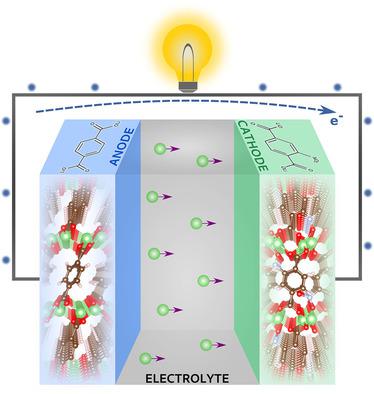当前位置:
X-MOL 学术
›
ChemSusChem
›
论文详情
Our official English website, www.x-mol.net, welcomes your
feedback! (Note: you will need to create a separate account there.)
Tuning the Electrochemical Properties of Organic Battery Cathode Materials: Insights from Evolutionary Algorithm DFT Calculations.
ChemSusChem ( IF 7.5 ) Pub Date : 2020-03-24 , DOI: 10.1002/cssc.201903450 Rodrigo P Carvalho 1 , Cleber F N Marchiori 2 , Daniel Brandell 2 , C Moyses Araujo 1
ChemSusChem ( IF 7.5 ) Pub Date : 2020-03-24 , DOI: 10.1002/cssc.201903450 Rodrigo P Carvalho 1 , Cleber F N Marchiori 2 , Daniel Brandell 2 , C Moyses Araujo 1
Affiliation

|
Several forms of organic materials have arisen as promising candidates for future active electrode materials for Li-ion and post-Li-ion batteries, owing to a series of key features that encompasses sustainability, accessibility, and tunable electrochemical properties by molecular modifications. In this context, a series of organic electrode materials (OEMs) are investigated to further understand their thermodynamic and electronic properties. Through an evolutionary algorithm approach combined with first-principles calculations, the crystal structure of lithiated and delithiated phases of these OEMs and their respective NO2 -substituted analogues are predicted. This framework allows a first assessment of their electrochemical and electronic properties and further understanding on the effects of the nitro group in the substituted compounds. NO2 is found to strongly affect structural and thermodynamic aspects during the electrochemical reaction with the reducing equivalents (Li+ +e- ), changing the OEM's character from a low-potential anode to a high-potential cathode by creating a localization of the additional electrons, thus resulting in a better-defined redox-active center and leading to a shift in the potential from 0.92 V to 2.66 V vs. Li/Li+ .
中文翻译:

调整有机电池阴极材料的电化学性能:进化算法DFT计算的见解。
由于包括通过分子修饰的可持续性,可及性和可调电化学特性在内的一系列关键特性,几种形式的有机材料已成为未来锂离子和锂离子后电池活性电极材料的有希望的候选者。在这种情况下,对一系列有机电极材料(OEM)进行了研究,以进一步了解其热力学和电子特性。通过进化算法方法与第一性原理计算相结合,可以预测这些OEM及其各自的NO2取代类似物的锂化和去锂化相的晶体结构。该框架允许对它们的电化学和电子性质进行初步评估,并进一步了解取代化合物中硝基的作用。
更新日期:2020-03-24
中文翻译:

调整有机电池阴极材料的电化学性能:进化算法DFT计算的见解。
由于包括通过分子修饰的可持续性,可及性和可调电化学特性在内的一系列关键特性,几种形式的有机材料已成为未来锂离子和锂离子后电池活性电极材料的有希望的候选者。在这种情况下,对一系列有机电极材料(OEM)进行了研究,以进一步了解其热力学和电子特性。通过进化算法方法与第一性原理计算相结合,可以预测这些OEM及其各自的NO2取代类似物的锂化和去锂化相的晶体结构。该框架允许对它们的电化学和电子性质进行初步评估,并进一步了解取代化合物中硝基的作用。











































 京公网安备 11010802027423号
京公网安备 11010802027423号